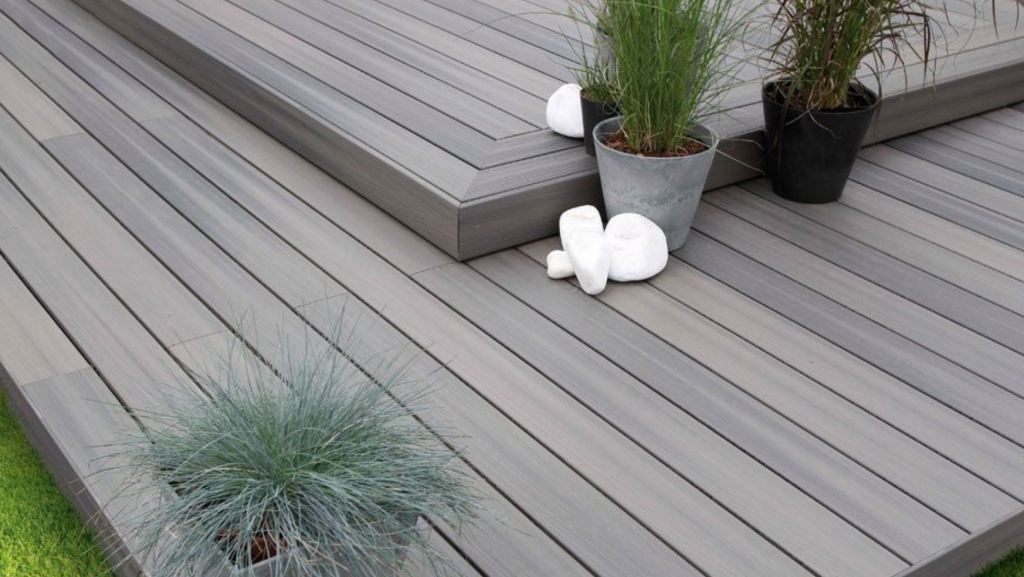If you are considering adding a timber deck to your alfresco area, then you may want to consider composite decking as a more durable, long lasting and low maintenance option.
So what is composite decking and how is it made ? Composite decking products are made up of a combination of wood and plastic fibres. The wood component can range from wood chips, sawdust and wood fibre pieces. The plastic component can consist from either newly manufactured plastic, to environmentally sustainable recycled plastic. The use of recycled plastic makes this a huge win against our efforts to reduce landfill and carbon emissions.
Another advantage of composite decking is that because composite decking is an industrially produced and manufactured item, and not a natural material, a more standard finished product can be guaranteed. In terms of colour, length and shape, every composite decking board will be mostly identical and the finished result will be more seamless that that of natural timber.
As the supply quantity of natural hardwood timbers become more scarce, due to the introduction of strict import and exporting guidelines and general environmental awareness, the cost associated has now become more inflated than recent years. This change in the timber market has allowed composite decking to now become quite cost competitive.
Composite decking is available in a wide range of colours, textures and styles giving you ample choice. Composite decking is also now growing in popularity as faux timber product are hitting a current trend in the home renovator market.
It is important to remember that not all composite decking is the same , and the manufacturing process and materials have also changed and improved over the years. There are two types of plastic used for manufacture in Australian composite decking products. The first is high density polyethylene ( HDPE )
HDPE is a soft , flexible material. This would be the most common plastic component forund in Australian composite decking products. HDPE is most commonly sourced from recycled materials such as milk bottles or pure virgin polymer. The downside to using recycled HDPE is that low grades of HDPE are not meant for exterior use, making it less fire resistant and also a higher risk of deterioration. To offset this issue, manufactures have had to include fire retardant additives during the manufacturing process, making the product slightly less environmentally friendly due to the chemical makeup. This is why virgin HDPE is added. The combination of both recycled and virgin materials results in a superior , durable product.
The second material is PVC. PVC is a hugely popular building material that you will find used around your home. Most commonly we would find PVC downpipes and gutters used in our homes. PVC is a hard plastic that is fire resistant and also UV resistant. PVC is well suited to exterior , weather-prone areas. The downside to PVC plastic component in composite decking would be first of all the texture . As PVC is a hard ,material , the feeling under foot would not mimic the feel of natural timber. The second would be the degree of difficulty upon installation due to the lack of flexibility.
The wood fibre is also an important component to composite decking products. It is used as a filler in the production process to reduce the manufacture cost of composite decking products. Generally there would be less than 50% timber fibres and as you would expect , hardwood timber fibres would outperform the durability of soft wood timber fibres.
Installation of composite decking products can be different from natural hardwood timbers. There are options of screws and concealed fixing systems. Manufacturers will recommend their preferred method depending on the composite decking product chosen. Some Composite decking boards will expand and contract as much as 1 mm with every 4 degree Celsius of fluctuation in temperature. In this case , specific fixing systems are used and spacing between boards and abutting wall are larger.
The maintenance of your composite deck is fairly simple. Just wash down and clean every few months , no oil is required to maintain the material. This fact alone is what makes composite decking an attractive option for residents. Many families are simply time poor and can think of better ways to spend their spare time than maintaining the outdoor decking area.

